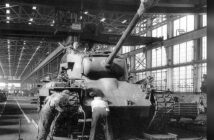The storied history of Flint’s famed athletic tradition is missing a complete chapter about one of the best to ever play the game of baseball. It’s the story of Dave “Wahoo” Hoskins – without question one of the greatest baseball players and athletes that no one has ever heard of. Sure, he’s enshrined in the Greater Flint Area Sports Hall of Fame, as he should be; but even that drew little interest beyond the normal chatter surrounding his induction in 1983.
Hoskins’ story is opaque for a lot of reasons, the least of which is that it begins with confusion. He told folks he was born in Mississippi in 1925 and came to Flint in 1936, where he almost immediately started playing games in the Flint City League. That would be beyond incredible, especially given the level of talent in that league at the time. An 11-year-old playing didn’t make sense … he must have played high school ball, right? But a scouring of Flint Central and Flint Northern baseball rosters didn’t reveal him as ever having attended any Flint high school.

Hoskins’ professional career began in the Negro Leagues, signing with
the Homestead Grays in 1944. He was the first Black player to compete
in the Southern and Double-A Texas Leagues.
Then, the truth was revealed. A search of old census reports showed that Hoskins was indeed born in Greenwood, Mississippi – but in 1917. He attended high school at G.H. Jones Industrial School in Highlandale, MS. Undoubtedly, Hoskins fibbed about his age to help his baseball career, where youth has always been at a premium. Regardless of the reason, the age switch stuck and in those days, no one bothered to check, or really could have done so effectively had they wanted to.
Whether Hoskins played for the Highlandale school team or not is still unknown; but his strict father had definitely let him start playing baseball after completing his chores, according to Dave’s brother Bill “Doc” Hoskins. When he arrived in Flint in ’36, a 19-year-old Hoskins was indeed ready for the Flint City League competition. In fact, he dominated the league for four years, hitting .438, .438, .350 and .412 while expertly patrolling the outfields.
Playing in the era of racial discrimination and Jim Crow prevented Hoskins from making a leap to Major League Baseball or even the MLB Minor League systems. Jackie Robinson’s breaking of the color barrier was still a World War and seven years away. But the league that was available to Hoskins was just as good from a competition and talent perspective. The Negro Leagues housed some of the world’s greatest talent, and the best team in that league was interested in signing him. In 1944, the 27-year-old Hoskins signed with the Homestead Grays.
The team featured a “Murderers Row” comparable to the New York Yankees famed lineup of the same name that included Earle Combs, Mark Koenig, Babe Ruth, Lou Gehrig, Bob Meusel and Tony Lazzeri. For the Grays, that lineup consisted of Sam Bankhead, Jerry Benjamin, James “Cool Papa” Bell, Buck Leonard, Josh Gibson and Flintstone Dave Hoskins. No one who saw both teams play believed there was much difference between the two units. In fact, Gibson is considered by many to be the greatest catcher in all of baseball history, and often compared to Ruth as a hitter. Leonard is compared to Gehrig and as for Hoskins, his MLB comparable was none other than the magnificent Stan “The Man” Musial – easily one of the greatest players in Major League history.
Pretty good company.
Once Black players were allowed to play in the MLB, there was still a fair amount of confusion about who and how. There were so many great Black players, it was going to be tricky for teams to discern who they should pursue. For other teams, the resistance to integration was a tough nut to crack. The Detroit Tigers didn’t field a Black player until Dominican Ozzie Virgil broke that barrier in 1958.

Sloan Museum of Discovery Archives Photograph Collection,
People Files-Hoskins, Dave. 1993.44.127_003_a

In 1953, Hoskins joined the Cleveland Indians and became a starting pitcher. The Indians won the American League pennant that year and Hoskins was on the World Series team of 1954.
Overall, the American League lagged the National League in integrating their rosters. The legendary Satchel Paige told Detroit Tiger legend Hank Greenberg, then the general manager of the Cleveland Indians, “You better sign this fella. He can hit. I know, because I couldn’t get him out!” It was the Indians who would listen and sign the hard-hitting (left-handed) Hoskins.
The thing about his hitting was that he was an equally good pitcher – a truly rare combination shared by only a few at the pro level, most notably Babe Ruth and currently, the Los Angeles Dodgers’ Shohei Ohtani. So, it was that Hoskins turned to Paige for advice and walked away from that conversation deciding to become a top-tier professional pitcher instead of a hitter. “I was tired of pitchers throwing at me and made up my mind to throw at other guys, instead,” Hoskins said, by way of explaining his decision.
Hoskins became a Minor League version of Jackie Robinson, becoming the first Black player to compete in the Southern League and the Texas League. He endured more than his share of catcalls and even death threats as he integrated the Minors. But he persevered with class and grace, and enough talent to make the Big Leagues.
In 1953, he joined the Cleveland Indians, becoming a starting pitcher on a staff that included Hall of Famer and one of the game’s Top 10 greatest pitchers, “Rapid” Bob Feller, and fellow Hall of Famers Early Wynn and Bob Lemon. The Indians won the American League pennant that year and Hoskins was on the World Series team of 1954. Feller said of Hoskins, “He just fit right in. He had that natural ability and used it when we needed it most. We all remember the part Hoskins played in that winning year in 1953.” Detroit Tiger great Al Kaline hit his first Major League home run off Hoskins when the Indians’ catcher set up a fastball down the middle (unbeknownst to Hoskins) as a “gift” to the rookie Tiger.
The Indians were swept by the Giants in that series, and that was the end of the Major League run for Hoskins, as well. That Tribe staff was one of the best ever, and it didn’t leave a lot of room for Hoskins. He went on to play Minor League ball. Hoskins could still play and came back to Flint to rule the Recreation League again, until his legs finally gave out and he called it a career.
Hoskins’ story is one that could have been quite different. Had he been allowed to play in the Majors at a younger age or had been older, or come along at a time when more players had college baseball as an option or a longer Minor League development period, it’s quite likely he would have been known as a Hall of Fame Major Leaguer, or one of the best Negro Leaguers ever – either way earning a plaque in Cooperstown.
Hoskins used his baseball earnings to buy a farm outside of Flint, and a cab company. He also worked at General Motors after returning to Vehicle City. With great love for the city, he always wanted to come home to Flint after his playing days were finished.
In 1970, he died of a heart attack at the age of 52 – gone far too soon and his story largely forgotten in a city of athletic superstars for far too long. But Dave Hoskins was one of the greatest athletes and baseball players in Flint history. In truth, his skills are notable in all of baseball history. That’s a fact worth remembering … and so is Dave “Wahoo” Hoskins.














